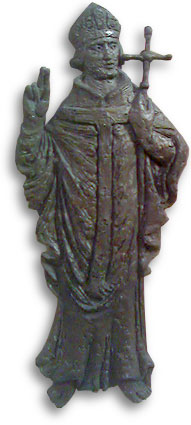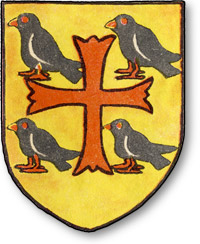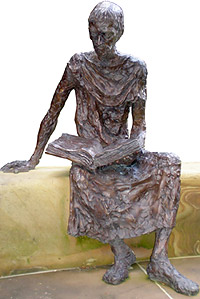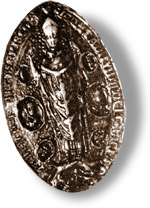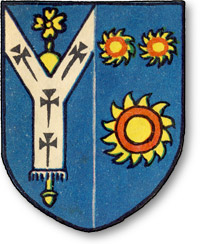
|
A Short Life of St Edmund of Abingdon
Feast Day: 20 November
He must have been something of a character in the eyes of the students. Long hours at night spent in prayer had the result that he often 'nodded off' during his lectures. Like any of us who find ourselves in that embarrassing position, he would wake with a start and say: 'I was not asleep - just thinking'. He would not take any payment from poor scholars, and when the richer scholars came to pay, he would ask them to leave the money on his window-sill, so as not to embarrass them if it was not quite the right amount. One of his dictums of this period reveals him as the scholar and the saint: 'Study as though you are to live for ever: live as though you are to die tomorrow'. There is a long-established tradition that he utilised his lecture-fees to build the Lady Chapel of St Peter's in the East at Oxford. Richard Poore appointed him Treasurer of Salisbury Cathedral in 1222, with the annexed prebend of Calne, and he had the responsibility of raising the money to complete the choir of the Cathedral. After the death in 1231 of Richard le Grand, Archbishop of Canterbury, the Canterbury Chapter proposed as his successor first Ralph Neville, Bishop of Chichester, then their prior, John of Sittingbourne, and then John Blund, canon of Chichester, but for one reason or another the Pope refused to confirm any of these appointments. Since the See had been vacant for four years, Pope Gregory IX personally intervened and 'gave the monks power to elect Master Edmund, Canon of Salisbury'. It was a surprising appointment for, apart from his learning, Edmund was known mainly as an ascetic and a recluse. Indeed, on his first visit to Rome in 1238, Pope Gregory was to chide him: 'You would make a good monk', but it was this same Gregory who had personally chosen him to be archbishop. Edmund was genuinely reluctant to accept office. He hesitated, apparently for two days, and the argument which finally broke down his resistance was that, if he refused, the Pope might very well appoint a foreign ecclesiastic to the archbishopric. He was consecrated at Canterbury on Laetare Sunday, 2nd April 1234.
He had immediate success, but it was virtually his only success. Within months of his consecration, by fearlessly exposing the evils which were threatening the land, he averted civil war and reconciled Henry III and the Barons, and the King was forced to expel the Poitevins. The reason for Edmund's success was undoubtedly the high regard in which the men of his day held physical penances and Edmund had practised these to an extraordinary degree since youth. Men listened to him because of his virtue. It is of special interest to us in Dover that one of the Barons who was reconciled with the King was Hubert de Burgh, Earl of Kent. De Burgh had founded the Maison Dieu in 1203, and in 1216 had successfully defended Dover Castle, and defeated the French in a naval engagement in the Channel. Edmund's success, however, turned the King against him, and the appointment of Cardinal Otto as Papal Legate, at the King's request, has been seen as a move to embarrass Edmund. In fact, Otto was a reasonable man, whose advice was sought both by Edmund and by Grosseteste, who did not meddle in the purely domestic affairs of the English Church, and who could not be bought by the King. He did, however, introduce foreign clerics to English benefices, which aroused strong opposition among the English Bishops, and was the cause of a deterioration in relations between Edmund and the Pope, The Pope advised him to accept the inevitable gracefully, and although Edmund counselled his fellow bishops 'to make a virtue of necessity', his own principles were too strong, and it was still a ground of bitter contention between him and the Pope at the time of his death Edmund was not intended by nature to be a bishop. He was happiest at Oxford or in his rectory at Calne: among ordinary people, instructing them, teaching them to pray: 'five words well said are better than five thousand said without devotion'), reconciling sinners and helping them to die. By our standards, his moral teaching was incredibly severe. He condemned luxury or comfort in any form, and was distrustful of sex. He held that a man could not be good and live at court. He prayed much and treated his body mercilessly In the thirteenth century he was every man's idea of a saint. He was not an administrator and had little time for what we would call routine work.
His complaints against the King were many. Not only did Henry delay the appointment of bishops so that he could have possession of the ecclesiastical revenue during the vacancies, but he raised levies on the Church to pay for his won and the Pope's needs. After his marriage to Eleanor of Provence, foreign ecclesiastics from her retinue had been appointed to English benefices, and more recently he was gerrymandering the Winchester Chapter to secure the appointment of a relative as bishop. Yet a further source of friction was Edmund's opposition to the marriage of Simon de Montfort to the King's sister because of her vow of perpetual widowhood. His seven years as Archbishop were unhappy years. The most serious of his conflicts, however, was with the monastic Chapters of Canterbury and Rochester. Originally, bishops had been monks and members of the monastic communities, but in the thirteenth century, with the rise of secular bishops, there was an inbuilt danger of conflict between them and the monks who formed their cathedral chapters. Each was concerned to prevent any encroachment upon their privileges. In Edmund's case, tension was heightened by his desire to establish a secular collegiate house at Maidstone to provide for clerics on his administration staff. It was a reasonable proposal, and Cardinal Otto had held an enquiry and approved his plans, but the monks were suspicious that their position was being undermined.
Although feelings between Edmund and the monks were bad, the issues between them were relatively small. The latest was over the right to nominate the prior and some petty forgeries were involved. It was the general situation as much as any one incident which led to Edmund's excommunicating the whole Cathedral Chapter. There was enough to discuss with the Pope when Edmund set out for an ad limina visit to Rome in October 1240 - his relations with the Pope, his relations with the Canterbury monks - but when he reached Pontigny he was a dying man. He turned back in the hope of reaching England, but death overtook him in a small Augustine priory at Soisy on 16th November 1240. The scenes described on page 11 give an idea of the veneration in which people held him. His cult is certainly as popular in France as in England. He was canonized by Innocent IV on 16th December 1246, at Lyons. Eustace of Faversham had already written his Life as part of the general presentation of his cause of canonization. This Eustace was a monk of Christ Church, Canterbury, and Edmund's chaplain. Edmund feared that the monks at Canterbury might take vindictive action against Eustace on account of his loyalty to him, and one of his last acts at Soisy, three days before he died, was to write a testimonial letter, indemnifying him in advance against any action the monks might take. It was also, no doubt, for the same reason that he had written the previous March to the sub-prior and monks of St Martin's Proiry at Dover, appointing Eustace to be their prior, although there is no evidence that he ever held the appointment.
It might be felt that, because of all the conflicts around him, Edmund had a contentious character. He was an Englishman and a strong nationalist, and was determined to rid England of foreign influences, whether these were foreigners in high political places, or high ecclesiastical places. He was more successful in the first than in the second. He was a Churchman, determined that the Church should be in the hands of men dedicated to God and to the people, and free of political influence to do its work unhampered: determined too, that its revenue should be spent on the needs of worship and on the needs of the poor, and not on luxurious living, the King's favourites or foreign wars. And he was a saint for whom holiness, his own and his countrymen's, took precedence before all else. In any age, such a man will meet opposition, but in the thirteenth century he was not only opposed, he was admired. Holiness was the one weapon left to a churchman - there were enough diplomats and politicians. They could be deposed,, killed,, circumvented, but there was no answer to holiness. Death did not help - it only made a martyr. Holiness was recognised as right, but it prevented a challenge to be avoided, if at all possible. Henry III died on Edmund's feast day, 16th November 1272. One can be sure that Edmund assisted him by his prayers. In recognition of Henry's benefactions to the Maison Dieu the Master was required to arrange for a mass for the repose of his soul to be said annually on 16th November. The last of these masses was said on 16th November 1534. |
|

